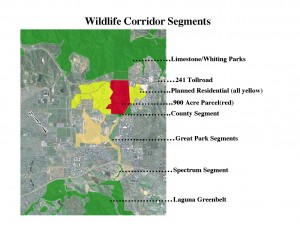
Plans for the FBI to assume stewardship of 900 acres that connect the Laguna Wilderness Park to the Cleveland National Forest will destroy land of enormous biological value, according to environmental and open-space protectionists.
“This will block the wildlife corridor and doom the Laguna greenbelt to a slow ecological death,” said Elisabeth Brown, president of Laguna Greenbelt, Inc., a wilderness preservation group.
The FBI plans to continue to use the acreage for target and explosives training. The land is now under the stewardship of the Federal Aviation Administration, which no longer wants to manage the property. If the FBI assumes stewardship, it has agreed to participate in “a working group” of concerned environmental organizations to determine how the corridor is managed.
The group includes the city of Irvine, which has taken a strong stand to preserve the habitat there. “It’s our objective to ensure that the wildlife corridor that has long been planned to the Cleveland National Forest is a reality and secured in perpetuity, preferably with the cooperation of the FBI,” said Sean Joyce, Irvine’s city manager. Joyce said the city would also like to establish a “firm baseline” with the FBI on its activities there.
Brown said preserving the 900-acre habitat, which she described as the “cork at the top” of a 5-mile corridor, is  as important to the health and diversity of the Laguna Coast Wilderness Park as preserving its 20,000 acres 20 years ago. That acquisition drew thousands of supporters marching up Laguna Canyon Road to preserve the canyon as open space.
as important to the health and diversity of the Laguna Coast Wilderness Park as preserving its 20,000 acres 20 years ago. That acquisition drew thousands of supporters marching up Laguna Canyon Road to preserve the canyon as open space.
Wildlife advocates fear the FBI will slip its plan to control the acreage under the radar without any public scrutiny of valuable habitat.
“Certainly there’s habitat,” said Laura Eimiller, FBI public affairs officer in Los Angeles, “but there is no established wildlife corridor at this time.”
Brown as well as Dan Silver of the Endangered Habitats League in Los Angeles, brought the FBI’s plan to assume stewardship to public attention several years ago. “Basically we have the government of the United States falling down on all its commitments and breaking all its promises,” claimed Silver, an M.D. whose first efforts in conservation preserved the Santa Rosa Plateau in Riverside County in 1989.
The El Toro property was slated as a reserve in 1996 but the U.S. Fish and Wildlife Services never declared it a refuge, according to the FBI’s environmental assessment report. The report says the FAA and FBI have cooperated with federal standards “to ensure the protection of wildlife and habitat resources at El Toro while accommodating existing land use and activities.”
Accommodating those uses, said Silver, reveals the problem. “We will lose control of it,” he said. “Over time, the FBI will encroach and encroach and encroach, and expand incrementally.”
The FBI now uses 200 acres of the habitat for three firing ranges, explosives training, a tactical maze, underground bunkers, two classrooms, paved and dirt roads and a 30-space parking lot, according to the report.
The FBI started with one firing range in a 10-acre side canyon, Brown said. “Nobody would have minded if they’d stayed there,” she said, “but they went ahead and constructed a new building there, new parking lot and another shooting range. There’s a whole series of underground bunkers.”
Eimiller said that the FBI’s use of the land falls within the footprint of the original agreement with the FAA and only renovation of existing buildings and firing ranges has occurred.
Lyn McAfee, executive director of the Nature Reserve of Orange County, said the FBI removed the reserve’s locks on gates to the acreage but will allow members in with advanced notice. “That acreage is within the boundaries of a federal and state conservation plan,” said McAfee. “We have worked with the FBI and they have been cooperative with us. Whoever has custody of that property we need to work with because it is part of the conservation plan.”
In the FBI’s report, the “El Toro” property, referring to the former Marine Air Base there, is “an extremely valuable law enforcement training facility because of its unique ability to offer different training opportunities in one location” and its proximity to Los Angeles.
“The FBI has no plans to expand operations and expects the nature and scope of its operations at El Toro to remain the same for the foreseeable future,” the report states, including abiding by the Endangered Species Act.
Brown thinks otherwise. “We don’t know what they’re doing. We don’t know what they’re planning, so there’s no way to evaluate if they’re going to change anything in the ‘foreseeable’ future,” she said.
Brown sees FBI stewardship as jeopardizing wildlife survival and genetic diversity, adding that the 900-acre corridor is the only pathway for indigenous animals, which need a wide travel range for survival, to the Cleveland National Forest.
“Everything is controlled,” she said. “There’s a big ugly fence and a big ugly sign. If you take a look at the photographs, it shows where they have gone on a building spree since 2007 when the fire came through. They have run wild.”




